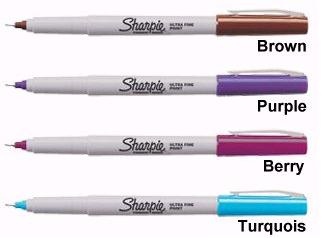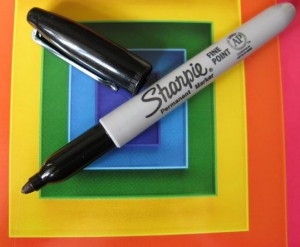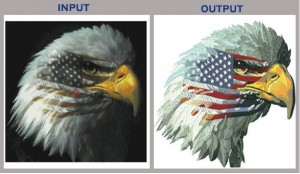Art and Embroidery
While the art requirements to digitize a design are not as high as other print mediums the ability to exactly duplicate an image is greatly reduced. There are primarily two reasons for this, embroidery does not have near the resolution of other print methods and embroidery cannot effectively duplicate any kind of opacity in an image.
Let’s look at these two issues independent from one another.
Resolution: Before you read anything further I want you to do something for me. Go find an Ultra Fine point Sharpie and as small and neatly as you can print your name.
Now, go get yourself a Fine Point Sharpie and print your name at the same size. Compare the results.
This is what your digitizer is up against when expectations are such that embroidery is requested to duplicate the resolution of a print/display version of a design. Embroidery simply does not have the resolution to match the resolution of even the lowest end printer or monitor.
To that end a digitizer has to look at your design and make decisions for how to best represent recreate art in an entirely different medium. Consider the image below. The art on the left has quite literally thousands of colors and very fine resolution. There is NO WAY this can be copied exactly so the digitizer must create an “illusion” of the original by using a mosaic of thread and stitch technique to best recreate the source image. This is not an easy thing to do and requires a skilled artisan.
Opacity: I have another experiment for you. I want you take a photograph (of anything) and place it on your desk. Then, I want you to take a whole bunch of thread and place it on top of the photograph. The result should be obvious. The more thread you put on top of the photograph (density) the less visible the photograph will be.
I know it might seem obvious but thread is a solid and when an image has an illusion of opacity (like a gauze of material covering a design element) this cannot be duplicated in embroidery. For example in the original image below the flag is transparent so you can see the feathers of the eagle head behind. In embroidered version there is no such thing as transparent thread so all we can do is emulate the look to the best of our ability. It is my opinion we have done an excellent job in this case but it should be understood it is not possible to duplicate the transparency of the flag. If the end user will not accept the artistic license required to get the design as close as we have here then it will most likely not be possible to please the customer.
In many cases the most powerful tool a person can use to understand this concept is common sense. For example, If you have a figure standing behind a window we can’t digitize the “glass” of it would cover the figure. Because of this it will almost always look like the window is open. There are of course techniques to create the illusion but whether or not the end result will be accepted is completely at the subjective discretion of whoever makes the final call.
As far as resolution goes…the best adivce I can give you is to always keep the “sharpie test” in mind. Qdigitzing (or any other digitizer) does not have a magic wand to defeat the laws of physics. The absolute minimum width of a line in an embroidered design is the width of a single piece of thread. If your art contains design elements that will be smaller than this your digitizer will be making accomodations. There is no way around it.
To sum things up, what separates the good digitizers from bad is how well they use the tools and materials available to them. It is also up to you to understand the limitations of the medium. When you are selling embroidery to a customer you should understand (think sharpie test) what embroidery can or cannot get away with. If you are are uncertain it is best to have a professional look at the art before you commit yourself to a project.
I look forward to hearing from each of you. If you have any questions please do not hesitate to reach out to me here or send an email to steve.freeman@qdigitizing.com.
Thank you,
Steve Freeman
Managing Partner
Qdigitizing.com
877-733-4390




Thanks Steve and crew……
I’ve had several designs digitized with you guys and the results are always the best…. I’ve discovered another technique that I really like and that is photostitch. Does Q-Digitizing do that kind of work? I have a program that I have been using with good results but looking for the best quality possible.
Thanks, Hank
Enjoyed your blog. As I am just getting started in the embroidery circuit it is helpful to get insight on the limitations as well as the diversity of digitizing. I thank you for your information.
This is an excellent article. I would like to make this into a piece I can give my customers. Would that be ok?
Thanks for all your work. I love you guys!
Feel free to use as you need. Thanks for the kind words.
Steve
Hi Hank,
At this time we are not offering the photo stitch technique.
Steve
I have recieved nothing but the best digitizing from your company and am always satisfied. recently you digitized a piece for me and it blew away the work that was digitized by a company that my customers were using!! they love your work.
Thank you